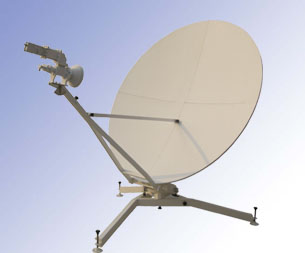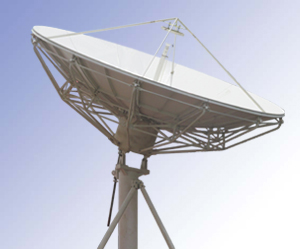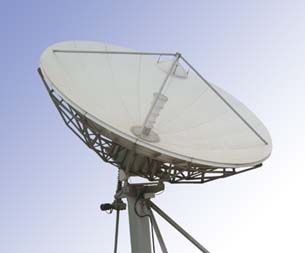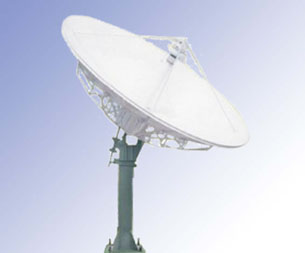news >> How to site an earth station antenna
| How to site an earth station antenna |
| Date:2010-12-09 22:37 Hits: |
How to site an earth station antenna Description Today's requirements for secure, interoperable communications systems, as well as rapidly deployable networks for emergency response, are driving the need for inexpensive, simple, satellite earth station antennas, ranging in size from sub-meter to 5 meters in diameter. When selecting and siting antennas, systems engineers rarely consider the earth station antenna's vulnerability to damage or destruction by the forces of nature or man. This article will tell you how to select the earth station antenna site. Content When selecting the location for an earth station antenna of any size, the primary consideration is to ensure a clear view of the orbital arc, which allows the antenna to "see" the maximum number of satellites. Placing an antenna on a rooftop is often the optimal solution. However, extremely high winds can damage or destroy a parabolic dish antenna. Most properly installed earth station antennas are designed to survive winds of at least 60 or 70 miles per hour. When located in areas prone to hurricanes, tornadoes, or seasonal periods of high winds that can exceed these speeds, special considerations should be made in selecting the location of the antenna. Properly siting the antenna can increase the chances of surviving high wind conditions. Locating an antenna on the leeward side of buildings or hillsides, or using large roof structures, such as air conditioning units as windbreaks, while maintaining a clear view of the orbital arc, can make the difference between an antenna's survival or destruction in a storm. As every rooftop antenna installation is unique, it is important to work with the building owner or landlord in order to determine the optimum location. Many manufacturers make antennas and antenna mounts capable of surviving higher wind conditions, than standard units. High wind antennas are more robust, and reinforced mounts should be considered in areas having an elevated risk of wind damage to outdoor structures. In the case of non-penetrating roof mounted antennas being installed in high wind areas, the maximum amount of ballast recommended by the manufacturer must be installed, or even exceeded, in order to ensure that the antenna does not move from its moorings during high wind conditions. The ability of the roof to bear this additional load must be considered to avoid damaging the building upon which the antenna is mounted. In general, hard mounting an antenna to a building is preferred over the use of a non-penetrating roof mount. Having a replacement antenna available in the event of an emergency is a costly, yet highly effective means of mitigating the risk of prolonged outages in crucial networks. Installing a second, fully equipped and operational antenna on a nearby building provides full redundancy, and "pace diversity" for the system. While costly, this risk mitigating option may be appropriate in high priority, high value communications networks. Earth station antennas providing high value, critical communications links must be protected against natural, and man-made threats. While some devastating situations are unavoidable, it is incumbent upon systems engineers to design a level of security and survivability into earth station facilities, which is commensurate with the importance of the communications traffic being carried by the facility. Selecting an appropriate location for the antenna can greatly increase its chances for surviving a storm or avoiding deliberate attack. Providing sufficient spares, and or redundancy/diversity can avoid outages or greatly reduce down time in the event of an interruption caused by either weather or attack. About Antesky Antesky Science Technology Inc. is specially engaged in designing, manufacturing and installing satellite communication earth station antenna and relevant servo equipments. We can offer a complete line of earth station antenna products and systems, such as Satellite communication antennas, earth station antenna , Rx antennas, SNG Antennas, Flyaway antennas, antenna control system and tracking system. |
| Related Articles |
- The Maintenances of Earth Station Antenna from Antesky
- Maintenance and Protection for Satellite Earth Station Ante...
- Antesky Introduces 4.5m Earth Station Antenna With High Qua...
- Antesky Introduces 7.3m Earth Station Antenna With Self-ali...
- Antesky Satellite Antenna Systems and Service
- Antesky Introduces 9.0 meter Dual-Reflector Earth Station A...
| Main Products |
| Products |
| Related Articles |
| Last articles |
- SES, Airbus Defence and Space Delivering Satcom Services to Enterprise Markets
- Antenna System for Tracking LEO and MEO Satellites launched by TeleCommunication Systems
- Arabsat and CETel Take part in African Extended C-band partnership
- 5,000 TrackPhone for mini-VSAT Broadband Network shipped by KVH
- AMC Networks Choose to Distribute Programming toCanadian MSOS with Telesat C-band Capacity
- China and France Support Agreement for Research Satellite
- Norsat Brings out 0.9 Meter Carbon Fiber Manpack
| Hot articles |
- Earth Station Antenna Tracking System Introduction
- How to Site VSAT Antenna - Rx/Tx antenna
- Application and Development of Flyaway Satellite Station in News Gathering System
- Earth Station Antenna New Technology
- How to site an earth station antenna
- 0.9 M or 1.2 M Ku-band Automatic Flyaway Antenna
- Antesky Introduces Flyaway Antenna
| Contact us |
Antesky Science Technology Inc.
ADD:Zhongtian International Mansion,Taibai South Road, Xi'an, Shaanxi, China
TEL:+86-29-88352448
FAX:+86-29-88352334
E-mail: sales@antesky.com
Website: http://www.antesky.com




